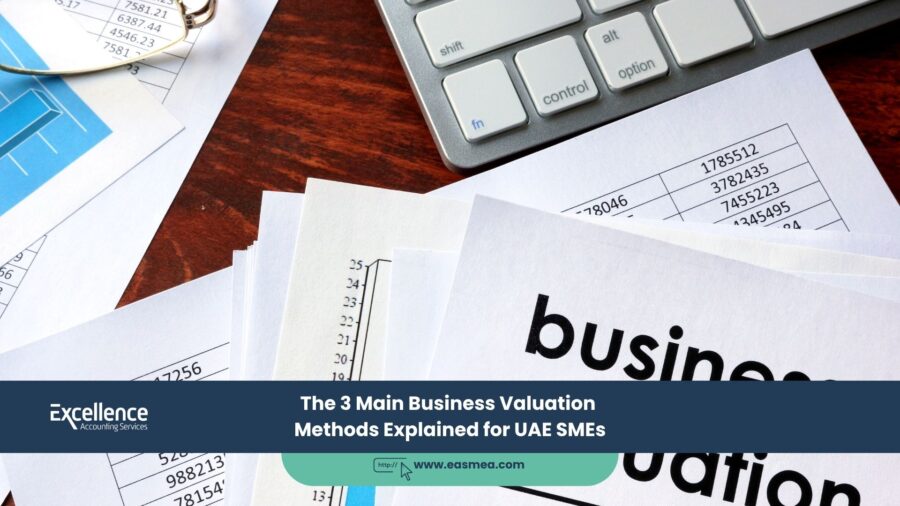The 3 Main Business Valuation Methods Explained for UAE SMEs
For any Small and Medium-sized Enterprise (SME) owner in the UAE, understanding the true value of your business is one of the most powerful pieces of knowledge you can possess. It’s a number that goes far beyond simple curiosity. Whether you are planning to sell your company, seeking investment to fuel growth, applying for a business loan, planning your exit strategy, or even settling a shareholder dispute, a credible and defensible business valuation is the essential starting point.
- The 3 Main Business Valuation Methods Explained for UAE SMEs
- Method 1: The Asset-Based Approach
- Method 2: The Market-Based Approach
- Method 3: The Income-Based Approach
- Determine Your True Worth with Excellence Accounting Services (EAS)
- Frequently Asked Questions (FAQs)
- What's Your Business Really Worth?
But what exactly determines the value of a business? It’s not as simple as looking at the cash in the bank or the price of your assets. Valuation is a blend of art and science, requiring a deep understanding of the business’s past performance, its position in the market, and its potential for future growth. In the dynamic and diverse economy of the UAE, selecting the right valuation method is crucial for arriving at a figure that reflects the true worth of your enterprise.
This guide will demystify the process by explaining the three primary business valuation methods used by professionals. We will break down the Asset-Based, Market-Based, and Income-Based approaches, explaining how they work, when they are most appropriate, and what they mean for your UAE-based SME. Armed with this knowledge, you can engage in strategic discussions with confidence and make decisions that maximize your company’s value.
Key Takeaways
- Valuation is Strategic: Knowing your business’s value is essential for selling, fundraising, succession planning, and strategic decision-making.
- Three Core Methods: The primary valuation approaches are the Asset-Based, Market-Based, and Income-Based methods.
- Asset-Based Approach: Values the company based on its net assets. Best for asset-heavy businesses or potential liquidations.
- Market-Based Approach: Compares your business to similar companies. Its accuracy depends on the availability of comparable data.
- Income-Based Approach: Focuses on future earning potential, often using Discounted Cash Flow (DCF). This is typically the most comprehensive method for profitable, growing businesses.
- No Single “Right” Answer: A credible valuation often uses a combination of methods to arrive at a defensible range. Professional business valuation services are key.
Method 1: The Asset-Based Approach
The Asset-Based Approach is the most straightforward of the three methods. It calculates a company’s value by summing up all its assets and subtracting its liabilities. The resulting figure represents the company’s net asset value. This method essentially asks: “What would be left over for the owners if the company sold all its assets and paid off all its debts today?”
Adjusted Net Asset Method
The most common form of this approach is the Adjusted Net Asset Method. This goes one step further than simply taking the “book value” from the balance sheet. It involves adjusting the value of each asset and liability to its current fair market value.
- Assets: A property bought ten years ago is likely worth more than its value on the books. Accounts receivable may need to be adjusted downwards to account for potential bad debts.
- Liabilities: All known and contingent liabilities must be accounted for.
Formula: Fair Market Value of Assets – Fair Market Value of Liabilities = Adjusted Net Asset Value
When is it most useful? The Asset-Based Approach is best suited for asset-heavy businesses like manufacturing, real estate holding companies, or distribution firms. It’s also the primary method used when considering a business for liquidation, as it determines the baseline value of its tangible parts. However, it often fails to capture the value of intangible assets like brand reputation, customer relationships, or intellectual property.
Method 2: The Market-Based Approach
The Market-Based Approach operates on the principle of comparison. It determines the value of a business by comparing it to similar businesses that have recently been sold or are publicly traded. This is similar to how real estate agents value a house by looking at the prices of comparable homes in the same neighborhood.
Using Valuation Multiples
This method relies on “valuation multiples,” which are financial ratios based on the sale prices of comparable companies. Common multiples include:
- Price-to-Earnings (P/E) Ratio: Compares the company’s price to its net earnings.
- Price-to-Sales (P/S) Ratio: Compares the price to its total revenues.
- EBITDA Multiple: Compares the enterprise value to its Earnings Before Interest, Taxes, Depreciation, and Amortization.
Example: If similar private companies in your industry in the UAE have been selling for an average of 4x their EBITDA, and your company’s EBITDA is AED 2 million, the market approach would suggest a valuation of around AED 8 million (4 x 2,000,000).
When is it most useful? This method is powerful when there is good data available on comparable transactions. However, for private SMEs in the UAE, this can be a significant challenge, as the financial details of private sales are rarely disclosed. An experienced valuator must use their judgment and access to private databases to find relevant benchmarks. This method is often used in conjunction with others to provide a “real-world” sanity check. A thorough due diligence process is often required to verify the multiples.
Method 3: The Income-Based Approach
The Income-Based Approach is often considered the most comprehensive method for profitable, operating businesses because it focuses on the single most important driver of value: the ability to generate future cash flow. This method asks: “What is the present value of the profits this business is expected to generate in the future?”
Discounted Cash Flow (DCF) Method
The most widely used income-based method is the Discounted Cash Flow (DCF) analysis. This is a multi-step process:
- Forecast Future Cash Flows: The valuator projects the company’s expected free cash flow over a specific period (usually 5-10 years).
- Determine a Discount Rate: A “discount rate” is calculated to account for the risk associated with the investment. A higher risk means a higher discount rate.
- Calculate Terminal Value: An estimate is made of the company’s value at the end of the forecast period.
- Discount to Present Value: All the future cash flows and the terminal value are discounted back to today’s date using the discount rate. The sum of these discounted values is the estimated value of the business.
When is it most useful? The DCF method is the gold standard for valuing most stable, profitable SMEs, from service businesses and tech companies to retail and F&B. Its strength lies in its focus on future potential rather than just past performance. It directly links the company’s value to its ability to generate cash for its owners. A detailed feasibility study can provide the robust forecasts needed for an accurate DCF analysis.
| Valuation Method | Core Concept | Best For… | Primary Challenge |
|---|---|---|---|
| Asset-Based | Value of net assets (Assets – Liabilities). | Asset-heavy businesses, real estate, liquidations. | Ignores intangible assets and future earnings. |
| Market-Based | Comparison to similar sold businesses. | Providing a real-world benchmark; when good data exists. | Lack of comparable data for private UAE SMEs. |
| Income-Based (DCF) | Present value of future cash flows. | Profitable, growing businesses with predictable earnings. | Relies heavily on assumptions about the future. |
Determine Your True Worth with Excellence Accounting Services (EAS)
A business valuation is too important to be left to guesswork. At EAS, our team of certified valuation professionals provides objective, defensible, and comprehensive valuation reports tailored to the specific needs of UAE SMEs.
Our Business Valuation Services:
- Comprehensive Valuation Reports: We don’t rely on a single method. We use a combination of approaches to arrive at a well-reasoned valuation range, suitable for transactions, legal purposes, and strategic planning.
- Transaction Advisory: Whether you are buying or selling, we provide valuation expertise to support your negotiations and ensure you get a fair price.
- Financial Modeling: We build robust financial models that underpin our valuations and can be used for your internal financial reporting and planning.
- Due Diligence Support: Our valuation work is often integrated with financial due diligence to provide a complete picture of a target company’s health and value.
Frequently Asked Questions (FAQs)
No. A credible valuation rarely relies on a single method. A professional valuator will typically use at least two methods. For example, they might use a DCF (Income-Based) as the primary method and then use a Market-Based approach as a “sanity check” to ensure the result is in line with the market. The final valuation is often a weighted average or a range derived from multiple approaches.
Value is the theoretical worth of a business based on a rigorous analytical process. Price is what a buyer is actually willing to pay for it in a transaction. The price can be influenced by many factors not captured in a valuation, such as negotiation dynamics, the strategic importance of the business to the buyer, or the seller’s urgency. A good valuation provides a strong anchor point for these negotiations.
The cost varies widely depending on the size and complexity of the business, the purpose of the valuation, and the level of detail required in the report. A simple calculation for internal planning will cost less than a comprehensive, certified report required for a legal dispute or a major fundraising round. It’s best to get a specific quote based on your needs.
While you don’t need a formal valuation every year, it’s a good practice to have a clear idea of your company’s value at all times. You should seek a formal valuation whenever you are contemplating a major strategic event: planning to sell, seeking investment, setting up an employee stock ownership plan (ESOP), or for estate and succession planning.
Intangible assets are non-physical assets like brand recognition, customer lists, patents, trademarks, and goodwill. The Asset-Based method struggles to value these. The Income-Based and Market-Based methods capture their value implicitly. For example, a strong brand allows a company to charge higher prices and generate more cash flow, which is directly reflected in a DCF valuation.
The discount rate represents the rate of return an investor would expect for taking on the risk of investing in your business. It’s a critical input. It is typically calculated using the Weighted Average Cost of Capital (WACC), which considers the cost of both debt and equity financing and is adjusted for risks specific to the company, its industry, and the economic environment.
Online calculators can provide a very rough, preliminary estimate. However, they are not a substitute for a professional valuation. They use generic multiples and cannot account for the specific nuances of your business, the local UAE market, or your company’s unique risks and opportunities. For any serious purpose, a customized professional valuation is essential.
Immensely. Clean, audited financials give a potential buyer or investor confidence in your numbers. It reduces the perceived risk of the investment, which can lead to a lower discount rate in a DCF analysis and, therefore, a higher valuation. It also speeds up the due diligence process. Good accounting and bookkeeping is the foundation of a good valuation.
Yes. When valuing the equity of a company (the portion belonging to the owners), you first calculate the Enterprise Value (the value of the entire business operation). Then, you subtract the company’s net debt (Total Debt – Cash) to arrive at the Equity Value. So, higher debt leads to a lower equity value, all else being equal.
Goodwill is an intangible asset that is only created during an acquisition. It represents the amount paid for a company over and above its identifiable net asset value. It essentially captures the value of the target’s brand, customer relationships, and other unquantifiable assets that the buyer was willing to pay for. It is not something a company can create on its own books.
Conclusion: From an Art to a Science
Understanding your business’s value is fundamental to its strategic management. While the process can seem complex, it is rooted in logical principles. By understanding the three main valuation methods, you can better appreciate what drives your company’s worth and how professionals arrive at their conclusions. For UAE SMEs, moving from a vague sense of worth to a specific, defensible valuation number is a critical step in preparing for future growth, transition, and success.
What's Your Business Really Worth?
Our expert valuation team can provide the clarity you need to negotiate, plan, and grow with confidence.




